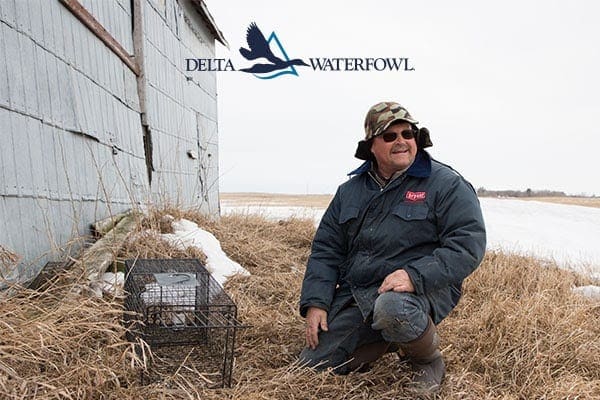Delta Waterfowl Begins Annual Predator Management Work to Boost Duck Production

This month, Delta’s professional trappers start the strategic removal of top nest predators across 26 sites in North Dakota and Manitoba
BISMARCK, NORTH DAKOTA — Mallards, pintails, teal and other duck species have begun to arrive at their breeding grounds in the prairie pothole region of Canada and the northern United States. The ensuing months are a critical time —and a dangerous one — for nesting hens and their eggs. Up to 90 percent of nests fail because of predators.
However, Delta Waterfowl is once again giving breeding ducks a fighting chance. The organization’s Predator Management program ramped up its annual efforts in March, which will boost duck production across 23 sites in North Dakota and three in Manitoba.
“Predator Management is the most efficient and cost-effective tool in our arsenal for increasing duck production in areas of high breeding duck densities, but low nest success,” said Joel Brice, Delta’s chief conservation officer. “Every year, the efforts of our professional trappers increase the survival of nesting hens, while also adding thousands upon thousands of ducks to the fall flight. And, of course, a large fall flight with an abundance of juvenile ducks is what leads to a thrilling waterfowl season.”
Alarmed by declining duck populations fueled by low nest success rates, The Duck Hunters Organization began studying Predator Management in 1994.
“Studies have shown that removing overabundant nest predators such as foxes, raccoons, and skunks — which historically were rarely present in many areas of the prairie landscape — leads to higher nest success for mallards, pintails and teal,” Brice said. “We know it works, so we’re investing our resources with one goal: to produce ducks.”
However, while Predator Management has proven effective, that doesn’t mean Delta’s innovative biologists aren’t striving to further refine its effectiveness. A new technique, known as “hotspot trapping,” focuses efforts on isolated patches of nesting cover within areas of high breeding duck densities, rather than trapping the entire traditional township-sized block.
“Hotspot trapping is another tool — an option that’s potentially more effective at increasing nest success in certain landscapes,” Brice said. “In recent years, we’ve documented increased hatch rates of two-, three- and even four-fold over areas lacking Predator Management.”
Additionally, Delta’s efforts at three research sites in Manitoba test Predator Management techniques for enhancing production of over-water nesting species such as canvasbacks, redheads and ring-necked ducks.
“Delta’s Predator Management program works remarkably well for dabbling ducks, which nest in the upland grass,” Brice said. “And we’re getting closer every year to unlocking a Predator Management strategy for major diving species. That would be a potential game-changer for canvasbacks.”
For more information about Delta Waterfowl’s Predator Management program, contact Joel Brice at (701) 226-7269 or jbrice@deltawaterfowl.org.
Delta Waterfowl is The Duck Hunters Organization, a leading conservation group working to produce ducks and ensure the future of duck hunting in North America. Visit deltawaterfowl.org.
